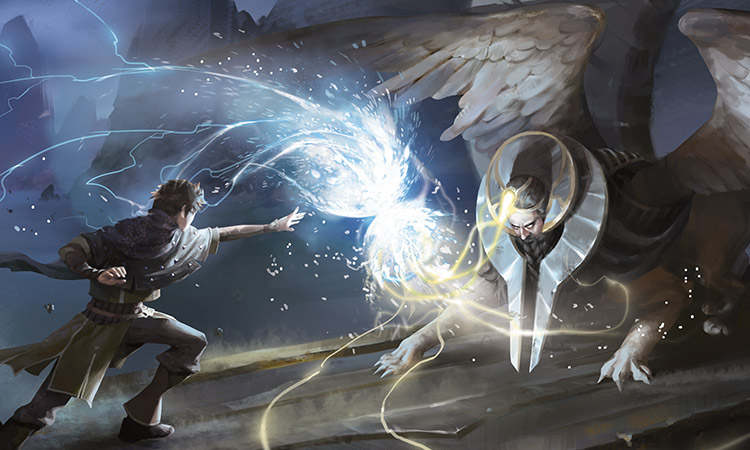Permission Spells
"Masters of the arcane savor a delicious irony. Their study of deep and complex arcana leads to such a simple end: the ability to say merely yes or no."

Calculated Dismissal | Art by Karl Kopinski
They're among the most feared spells in all of Magic. They're challenging to use properly, and terrifying to play against. Today we're going to discuss, in depth, permission spells.
What is a Permission Spell?
Permission spells have the ability to counter an opposing spell as it is being cast.
It's easy to understand why we call it "permission":
Johnny, staring down six untapped Islands on the other side of the battlefield, will say, "I'll cast Siege Rhino . . . Is that okay?"
And Jenny, after pondering her options, might say, "Yes, that's okay." Or she might say, "No, I'll cast Clash of Wills for five!"
The original permission spell was called "Counterspell." Counterspells can also refer, generally, to the category of cards as a whole.
"Counterspells" = "Permission Spells" = "Counters" = "Permission"
Many new players are confused by permission spells, probably because the cards are so unique in what they do. At various early points in my career, I remember trying to use Counterspell to destroy a permanent already in play (not legal), and trying to use Counterspell to stop my opponent from playing a land (not legal either).
While there are times when memorizing the technicalities of Magic is overly tedious, in the case of permission spells, it's very helpful. The following terms will definitely be familiar, but their exact definitions may or may not be.
Stack: The stack can feel like a scary concept when you first learn about it, but it's really not so bad. It's simply where spells and abilities wait to resolve. When you cast a spell or activate an ability, it goes on the stack, and both players get a chance to respond to it. If they choose not to, the spell or ability resolves as normal.
Spell: A spell only exists while it's being cast, while it's on the stack, and while it's resolving. You can use permission to remove a spell from the stack, before it has had its effect on the game. Instants and sorceries are spells as you're casting them. Creatures, planeswalkers, enchantments, and artifacts are also spells as you're casting them, but not once they're on the battlefield.
Permanent: Once they're on the battlefield, they're instead called permanents. A permanent is any card (or token) on the battlefield.
Land: Lands are permanents, but they are never spells. Playing a land is a special action and does not use the stack. In other words, it happens immediately, and cannot be countered or responded to.
Card: In zones other than the stack and the battlefield, everything is merely "a card." Just as you cannot use Path to Exile to remove a creature card from the graveyard, you can only use a permission spell on a spell that's currently on the stack.
Permission as Early Defense
One of the traditional weaknesses of the color blue is its shortage of removal spells. Instead, blue mages sometimes rely on permission to keep from falling behind in the early game.
One strength of using permission as early defense is that it can answer anything the opponent chooses to throw at you. Lightning Strike cannot kill Courser of Kruphix, and Ultimate Price cannot kill Fleecemane Lion; but Nullify can stop either.
Indeed, if you can keep from falling behind, your opponent might not be able to get a creature onto the battlefield in the early game at all!
A problem arises, however, if you do somehow fall behind. Permission spells cannot remove a creature or planeswalker from the battlefield, so if one slips through the cracks, you'll need another way to answer it.
When using them as early defense, permission spells have a slightly higher value when you're on the play than when you're on the draw—since you're less likely to fall behind. They can be excellent against medium-speed decks like Abzan. Decks like these sometimes won't play a creature until turn three, by which time you're ready to counter it.
However, they can fall short against blisteringly fast decks like Mono-Red or White Weenie. You won't be able to counter a turn-one creature (at least not in Standard), so you'll be starting the game with a big problem. Either you'll suffer a ton of damage from that creature, or you'll have to tap out to answer it with a removal spell or creature of your own. At this point, your shields will be down, and your opponent can resolve another threat. You'll have to tap out to answer that one, and if you're not careful, you can find yourself in a vicious cycle where your permission spells are largely useless.
For this reason, having a mix of permission and removal is often your best bet. There are matchups and situations where leaning too heavily on permission will be costly.
Pushing a Tempo Advantage
If I told you that the final spell cast in a game of Magic was Disdainful Stroke, what would you think might've happened in that game?
We tend to think of permission spells as defensive. After all, their purpose is to stop whatever the opponent is doing. However, sometimes they're best used to stop them from stopping you.
Here's one thing that could've happened: An aggressive blue deck had a fast start with some cheap creatures. On turn five, the opponent tapped out for End Hostilities, hoping to get back in the game, but the blue player countered it with Disdainful Stroke. One last attack ended the game, making Disdainful Stroke the last spell played—and very likely the winner's MVP!
Permission is poor when you're behind, good when you're at parity, and downright deadly when you're ahead.
Traditionally, blue-based aggressive decks are cold-blooded killers of slow, controlling decks. They get ahead early, and then sit back on counterspells to prevent the control decks from clawing back into the game.
Locking Up the Game
Another great thing about permission is that it maintains its value throughout the game. While you can often use it as early defense, or to push a tempo advantage, it can also help you lock up the late game. Permission can be important to the concept of inevitability.
Imagine that you're playing a late game control deck focused on card advantage. You've succeeded in fending off your opponent's early rush of creatures. Now you're in a dominant position, drawing countless extra cards off of Dig Through Time and Dragonlord's Prerogative. You see your opponent tap a land, then two, three . . . eight, nine lands . . . Crater's Claws for eight knocks you right out of the game! Just when everything was going so well!
This nightmare scenario can be avoided with the presence of a modest amount of permission. If blue is known for two things, it's its permission spells and card drawing, and the two make a deadly combination. Once you've taken control of the game, your card-drawing spells allow you to see a large portion of your library, and if there are even a few permission spells in there, you can use them to make sure the game doesn't slip through your fingers.
Permission in your Sideboard
Counterspells can make great sideboard options for aggro decks, control decks, and combo decks alike; virtually anyone with access to blue mana can consider some permission for their sideboard!
First off, permission spells in your sideboard won't be a liability against those super-aggressive decks that are going to put you on the back foot right away. Too many permission spells in your main deck would be.
Second, just like with removal spells, after sideboarding you can tailor your permission suite perfectly to beat the person sitting across from you. Disdainful Stroke is great against ramp decks like Green Devotion. Negate is excellent against controlling decks like Esper Dragons. Annul is stellar against Blue-Red Artifacts and Constellation decks.
Finally, many matchups slow down a bit after sideboarding, and you may need extra answers to whatever your opponent is bringing in against you. For example, you might normally consider a card like Ultimate Price to be your best weapon against Green Devotion, but if your opponent is siding in Nissa, Worldwaker against you, you might need to sprinkle in a few permission spells in order to be better prepared.
Permission in Limited
Everything you know about counterspells in Constructed is also true in Limited. The important factor to remember, though, is that decks in Limited—both yours and your opponent's—are likely to be less focused than they would be in Constructed.
In other words, balance is key. Make permission spells one extra tool at your disposal, but don't lean too heavily on them. It's great to have a small number of counters in either your main deck or your sideboard, but you'd want a special reason before you'd play with more than two or three.
Their stock goes up in Sealed Deck as compared to Booster Draft. Sealed Deck is slower and more centered around late bombs. An ordinary common like Bone to Ash can be the perfect answer for a bomb creature like Kothophed, Soul Hoarder. In fact, look to counters as perfect sideboard cards once you know whether or not your opponent has a late game bomb (and importantly, what it is).
Playing with Permission
We've touched on playing with permission spells in our previous discussions of tempo. Early in the game, you'll sometimes need to pull out all the stops in order to avoid falling behind on tempo. Don't be too proud to Dissolve a Foundry Street Denizen, if that's what the situation calls for!
Later in the game, though, you sometimes have the luxury of being more selective with your permission.

Clash of Wills | Art by Yan Li
Imagine you're playing a Blue-Black Control deck with a modest amount of permission in your deck (we'll say five counterspells), but you also have a lot of removal spells and a few creatures. When you play this deck against Abzan, it's important to use the right tools for the right jobs. If your opponent casts Anafenza, the Foremost, you can consider letting it resolve. After all, this is a card that you can answer just fine with a Hero's Downfall, Murderous Cut, or Languish. A morph that could be a Den Protector, however, will be troublesome if it hits the battlefield, so maybe you ought to save your Dissolve for something like that.
Important to note is that these questions are fluid and might change from one situation to the next. If you're at 20 life, you might let a Siege Rhino resolve and kill it with a removal spell. If you're at 5, maybe it's worth the Dissolve. If you expect to tap out for a creature on your next turn, maybe it's a fine call to counter Anafenza, just to keep the board under control.
Playing Against Permission
It's incredibly frustrating to have your game-winning spell countered. Sometimes, there's nothing much you can do to avoid it. Other times, there is.
Permission spells do have one weakness that can sometimes be exploited: They must be cast in a narrow window. If your opponent passes the turn with mana open for Dissolve, they've made a commitment of mana, and they must either use their Dissolve, or let it go to waste. If you suspect that your opponent is holding up a Dissolve, you can choose to cast your second-best spell, or perhaps not cast anything at all if you have that luxury.
If you can create a situation where you're ahead on the board, then your opponent won't be able to continue sitting on his or her counters. If your opponent passes with three Islands untapped, you might just want to attack with your Rakshasa Deathdealer and pump it up! After a few turns of this, you'll force your opponent to make the first move, and perhaps open a window for you to resolve a spell.

Rakshasa Deathdealer | Art by John Severin Brassell
In Standard, most permission-heavy decks will also be playing with board sweepers like Languish or End Hostilities. Plan for the turns where your opponent will tap out for these cards. For example, you don't want to let your opponent Dissolve your Siege Rhino, and then untap and Languish the rest of your creatures away. Instead, you might lead with one of your weaker creatures, saving the Rhino (perhaps your most important spell) for the turn your opponent taps out.
On certain turns, though, your opponent can hold open mana for a counter without letting anything go to waste. This would be on a turn where he or she is planning to cast an instant-speed card-drawing spell like Dig Through Time or Jace's Ingenuity. If you suspect that this is the case, it can sometimes be in your interest to play right into the counterspell, because at least you'll force your opponent to wait a turn on his or her other spell. It's all about making things as inconvenient as possible for the opponent.
All of these techniques can be applied when you feel like you have a good hint about what's in your opponent's hand. However, my last piece of advice is not to be too passive. The worst thing you can do is let the fear of a counterspell cause you to lose the game when your opponent doesn't have one at all! Each turn that passes with no action favors the late-game control deck, so you don't want to give them any more time than you have to.
When in doubt, err on the side of being aggressive. Your opponent won't always have it. If they do, oh well, you might not have been able to successfully play around it even if you'd tried.
Permission spells are an important, complex, and challenging part of Magic. However, there's no reason to be afraid of them. Understand their strengths and weaknesses. Learn how best to use them yourself. Learn when you can make them inconvenient for your opponent. These are skills that will serve you well throughout your Magic career.

